
The Avro Blue Steel was a British air-launched, rocket-propelled nuclear armed standoff missile, built to arm the V bomber force. It allowed the bomber to launch the missile against its target while still outside the range of surface-to-air missiles (SAMs). The missile proceeded to the target at speeds up to Mach 3, and would trigger within 100 m of the pre-defined target point.

The Rolls-Royce Pegasus, formerly the Bristol Siddeley Pegasus, is a British turbofan engine originally designed by Bristol Siddeley. It was manufactured by Rolls-Royce plc. The engine is not only able to power a jet aircraft forward, but also to direct thrust downwards via swivelling nozzles. Lightly loaded aircraft equipped with this engine can manoeuvre like a helicopter. In particular, they can perform vertical takeoffs and landings. In US service, the engine is designated F402.

The Rolls-Royce Spey is a low-bypass turbofan engine originally designed and manufactured by Rolls-Royce that has been in widespread service for over 40 years. A co-development version of the Spey between Rolls-Royce and Allison in the 1960s is the Allison TF41.

The Armstrong Siddeley Mamba was a British turboprop engine produced by Armstrong Siddeley in the late 1940s and 1950s, producing around 1,500 effective horsepower (1,100 kW).

The Bristol Siddeley Orpheus is a single-spool turbojet developed by Bristol Siddeley for various light fighter/trainer applications such as the Folland Gnat and the Fiat G.91. Later, the Orpheus formed the core of the first Bristol Pegasus vectored thrust turbofan used in the Harrier family.

The Rolls-Royce/SNECMA M45H is an Anglo-French medium bypass ratio turbofan produced specifically for the twin-engined VFW-Fokker 614 aircraft in the early 1970s.

The Bristol Siddeley BS.100 is a British twin-spool, vectored thrust, turbofan aero engine that first ran in 1960. The engine was designed and built in limited numbers by Bristol Siddeley Engines Limited. The project was cancelled in early 1965.
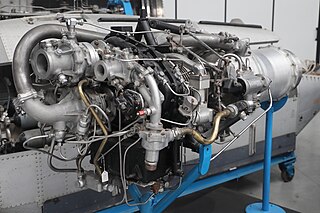
The de Havilland Spectre is a rocket engine that was built by the de Havilland Engine Company in the 1950s. It was one element of the intended mixed power-plant for combination rocket-jet interceptor aircraft of the Royal Air Force, such as the Saunders-Roe SR.177.

The Midland Air Museum (MAM) is situated just outside the village of Baginton in Warwickshire, England, and is adjacent to Coventry Airport. The museum includes the Sir Frank Whittle Jet Heritage Centre, where many exhibits are on display in a large hangar. It also has a small hangar, and a fenced-off green area where many aircraft are on display in the open.
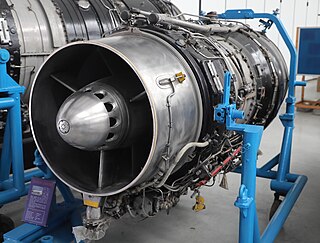
The de Havilland Gyron Junior is a military turbojet engine design of the 1950s developed by the de Havilland Engine Company and later produced by Bristol Siddeley. The Gyron Junior was a scaled-down derivative of the de Havilland Gyron.
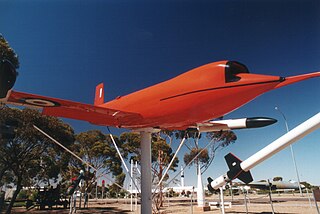
The GAF Jindivik is a radio-controlled target drone produced by the Australian Government Aircraft Factories (GAF). The name is from an Aboriginal Australian word meaning "the hunted one". Two manually-controlled prototypes, were built as the GAF Pika as a proof of concept to test the aerodynamics, engine and radio control systems, serialled A92-1/2, 'B-1/2'. The radio-controlled Jindivik was initially designated the Project B and received serials in the A93 series. Pika is an Aboriginal Australian word meaning flier.
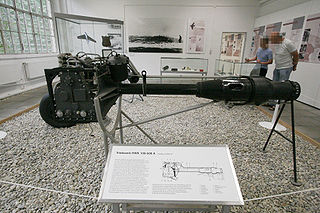
The Walter HWK 109-509 was a German liquid-fuel bipropellant rocket engine that powered the Messerschmitt Me 163 Komet and Bachem Ba 349 aircraft. It was produced by Hellmuth Walter Kommanditgesellschaft (HWK) commencing in 1943, with licensed production by the Heinkel firm's facilities in Jenbach, Austria.

The Armstrong Siddeley, later Bristol SiddeleyGamma was a family of rocket engines used in British rocketry, including the Black Knight and Black Arrow launch vehicles. They burned kerosene fuel and hydrogen peroxide. Their construction was based on a common combustion chamber design, used either singly or in clusters of up to eight.

The Napier Scorpion series of rocket engines are a family of British liquid-fuelled engines that were developed and manufactured by Napier at the Napier Flight Development Establishment, Luton, in the late 1950s. The Scorpion range were designed and flight tested as boosters to improve aircraft take-off performance.

The Armstrong Siddeley Stentor, latterly Bristol Siddeley BSSt.1 Stentor, was a two-chamber HTP rocket engine used to power the Blue Steel stand-off missile carried by Britain's V bomber force. The high thrust chamber was used for the first 29 seconds, after which it was shut down and a smaller cruise chamber was used for the rest of the powered flight.
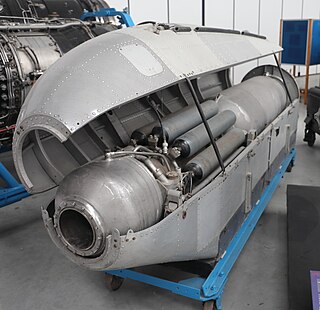
The de Havilland Sprite is a British rocket engine that was built by de Havilland in the early-1950s for use in RATO applications. A developed engine with slightly less thrust but a longer burn time was known as the Super Sprite, production ceased in October 1960.
The Armstrong Siddeley Snarler was a small rocket engine used for mixed-power experiments with an early turbojet engine. and was the first British liquid-fuelled rocket engine to fly.
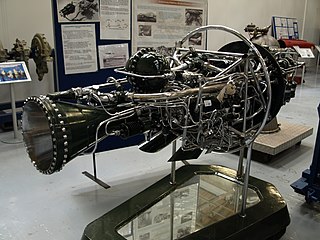
The Armstrong Siddeley Screamer was a British rocket engine intended to power the Avro 720 manned interceptor aircraft. Thrust was variable, up to a maximum of 8,000 lbf (36 kN).

Bluebird Mach 1.1 (CMN-8) was a design for a rocket-powered supersonic land speed record car, planned by Donald Campbell but thwarted by his subsequent death during a water speed record attempt in Bluebird K7 in early 1967.

The Avro 720 was an in-development British single-seat interceptor of the 1950s. It was designed and being developed by Avro in competition with the Saunders-Roe-built SR.53. While at least one prototype was partially-constructed, the order for the Avro 720, and quickly thereafter the project entirely, was terminated prior to any aircraft having been completed.



















